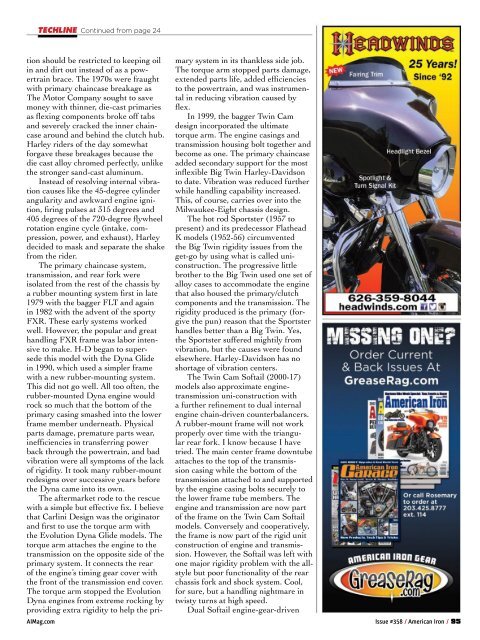American Iron Magazine December 2017
Create successful ePaper yourself
Turn your PDF publications into a flip-book with our unique Google optimized e-Paper software.
TECHLINE Continued from page 24<br />
tion should be restricted to keeping oil<br />
in and dirt out instead of as a powertrain<br />
brace. The 1970s were fraught<br />
with primary chaincase breakage as<br />
The Motor Company sought to save<br />
money with thinner, die-cast primaries<br />
<br />
and severely cracked the inner chaincase<br />
around and behind the clutch hub.<br />
Harley riders of the day somewhat<br />
forgave these breakages because the<br />
die cast alloy chromed perfectly, unlike<br />
the stronger sand-cast aluminum.<br />
Instead of resolving internal vibration<br />
causes like the 45-degree cylinder<br />
angularity and awkward engine igni-<br />
<br />
<br />
rotation engine cycle (intake, com-<br />
<br />
decided to mask and separate the shake<br />
from the rider.<br />
The primary chaincase system,<br />
transmission, and rear fork were<br />
isolated from the rest of the chassis by<br />
<br />
1979 with the bagger FLT and again<br />
in 1982 with the advent of the sporty<br />
FXR. These early systems worked<br />
well. However, the popular and great<br />
handling FXR frame was labor intensive<br />
to make. H-D began to supersede<br />
this model with the Dyna Glide<br />
in 1990, which used a simpler frame<br />
with a new rubber-mounting system.<br />
This did not go well. All too often, the<br />
rubber-mounted Dyna engine would<br />
rock so much that the bottom of the<br />
primary casing smashed into the lower<br />
frame member underneath. Physical<br />
parts damage, premature parts wear,<br />
<br />
back through the powertrain, and bad<br />
vibration were all symptoms of the lack<br />
of rigidity. It took many rubber-mount<br />
redesigns over successive years before<br />
the Dyna came into its own.<br />
The aftermarket rode to the rescue<br />
<br />
that Carlini Design was the originator<br />
<br />
the Evolution Dyna Glide models. The<br />
<br />
transmission on the opposite side of the<br />
primary system. It connects the rear<br />
of the engine’s timing gear cover with<br />
the front of the transmission end cover.<br />
<br />
<br />
mary<br />
system in its thankless side job.<br />
<br />
<br />
to the powertrain, and was instrumental<br />
in reducing vibration caused by<br />
<br />
In 1999, the bagger Twin Cam<br />
design incorporated the ultimate<br />
<br />
transmission housing bolt together and<br />
become as one. The primary chaincase<br />
added secondary support for the most<br />
<br />
to date. Vibration was reduced further<br />
while handling capability increased.<br />
This, of course, carries over into the<br />
Milwaukee-Eight chassis design.<br />
The hot rod Sportster (1957 to<br />
<br />
<br />
<br />
get-go by using what is called uniconstruction.<br />
The progressive little<br />
<br />
alloy cases to accommodate the engine<br />
that also housed the primary/clutch<br />
components and the transmission. The<br />
rigidity produced is the primary (for-<br />
<br />
<br />
the Sportster suffered mightily from<br />
vibration, but the causes were found<br />
elsewhere. Harley-Davidson has no<br />
shortage of vibration centers.<br />
<br />
<br />
transmission uni-construction with<br />
<br />
engine chain-driven counterbalancers.<br />
A rubber-mount frame will not work<br />
properly over time with the triangular<br />
rear fork. I know because I have<br />
tried. The main center frame downtube<br />
attaches to the top of the transmission<br />
casing while the bottom of the<br />
transmission attached to and supported<br />
by the engine casing bolts securely to<br />
the lower frame tube members. The<br />
engine and transmission are now part<br />
of the frame on the Twin Cam Softail<br />
models. Conversely and cooperatively,<br />
the frame is now part of the rigid unit<br />
construction of engine and transmission.<br />
However, the Softail was left with<br />
one major rigidity problem with the allstyle<br />
but poor functionality of the rear<br />
chassis fork and shock system. Cool,<br />
for sure, but a handling nightmare in<br />
twisty turns at high speed.<br />
Dual Softail engine-gear-driven<br />
AIMag.com Issue #358 / <strong>American</strong> <strong>Iron</strong> / 95


